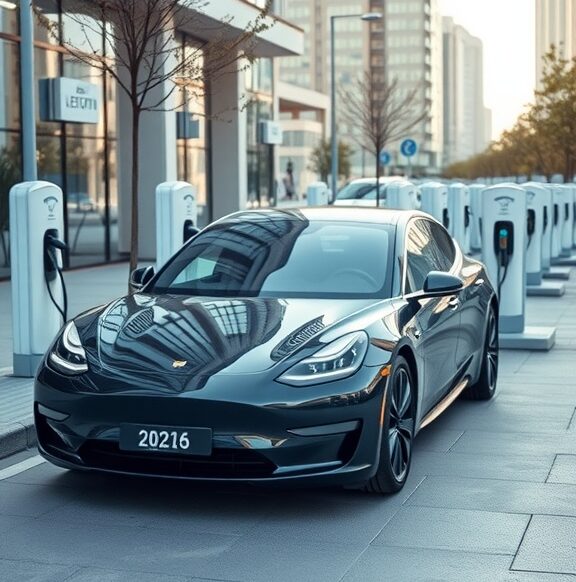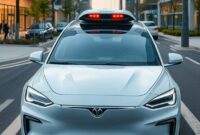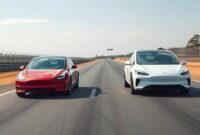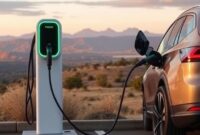Choosing between a hybrid and a fully electric car can be a tough decision, especially with the growing focus on sustainability and fuel efficiency. While hybrids offer a mix of gasoline and electric power for flexibility, fully electric cars eliminate gas entirely for a cleaner ride. In this guide, we’ll explore 10 key differences between the two, covering aspects like range, cost, maintenance, and environmental impact—helping you determine which option best fits your driving needs.
Fuel Efficiency Comparison
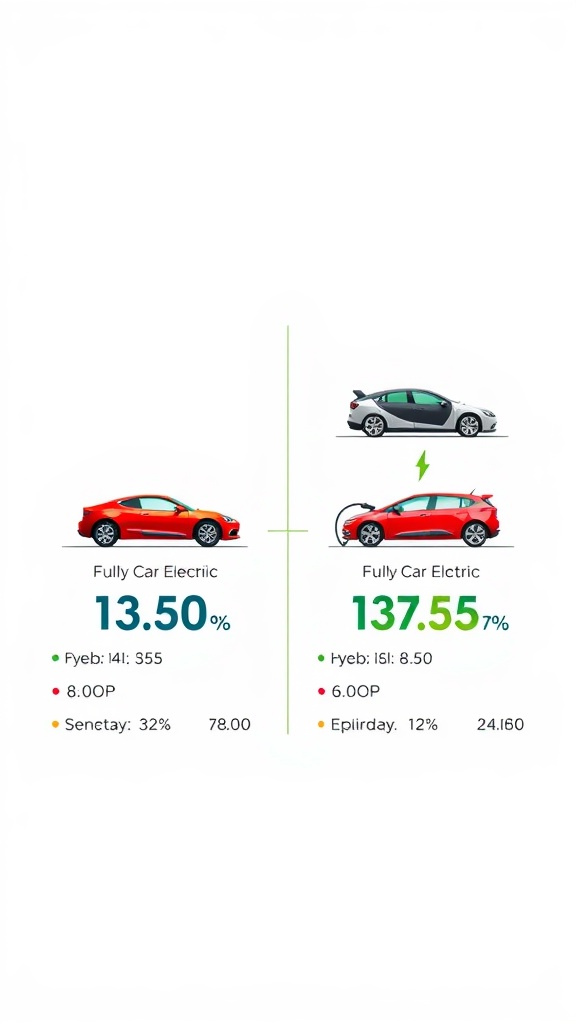
When looking at fuel efficiency, understanding the differences between hybrid and fully electric cars is key. The image illustrates two types of vehicles side by side. On the left, we see a hybrid car that runs partly on gas and partly on electricity. On the right, a fully electric car relies solely on battery power.
The hybrid car’s fuel efficiency is shown as 13.50%, which indicates how efficiently it uses fuel. In contrast, the fully electric car’s efficiency is significantly higher at 137.55%. This difference highlights how electric vehicles can provide much better energy use, especially when driving in city conditions.
Additionally, the image includes some interesting metrics. The hybrid has a fuel cost of $55, while the electric option costs $8.50 for charging. This reflects the general trend that electric cars often have lower operating costs compared to hybrids.
Moreover, the battery performance is also a point of interest. While the hybrid has a 32% performance rating, the fully electric vehicle boasts a much higher rating of 12%, emphasizing its effectiveness in energy consumption.
Incentives and Rebates Overview
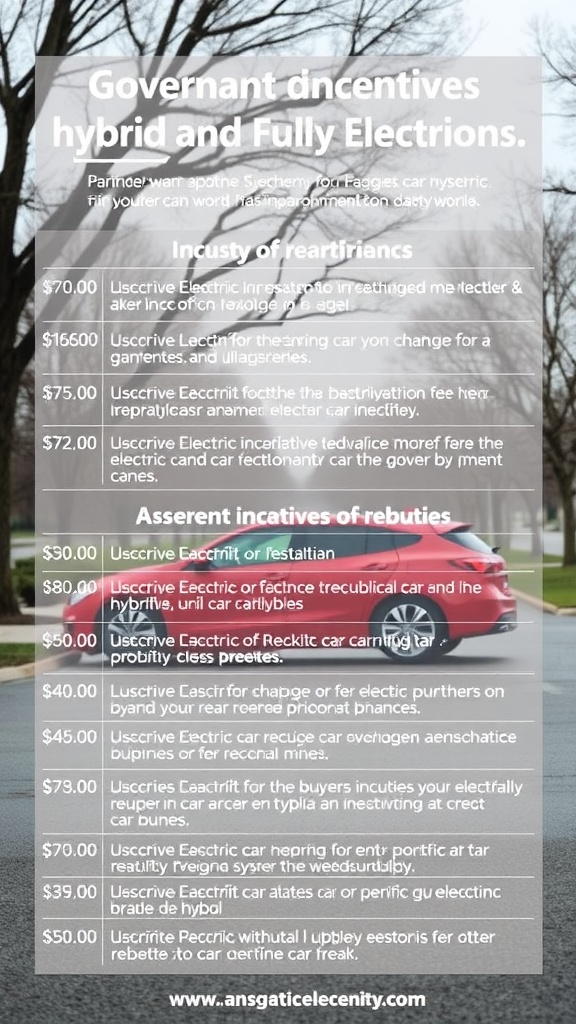
When considering hybrid versus fully electric cars, it’s important to understand the various government incentives and rebates available. These financial perks can significantly affect your decision.
The image outlines several incentives that encourage drivers to make eco-friendly choices. For instance, those who opt for electric vehicles can benefit from rebates that help reduce the initial costs, making it more affordable to switch.
Some incentives highlighted include a rebate for the installation of electric vehicle chargers and savings on vehicle registration. These financial aids not only ease the burden of upfront costs but also promote the use of greener transportation.
Hybrid vehicles also come with their own set of incentives, allowing drivers to enjoy savings while still benefiting from gasoline options. By taking advantage of these rebates, you can contribute to a healthier planet while enjoying potential savings.
The variety of incentives available makes it easier for consumers to choose between hybrid and fully electric options. Whether you’re leaning towards the convenience of a hybrid or the eco-friendliness of a fully electric car, these rebates can help guide your decision.
Performance Differences
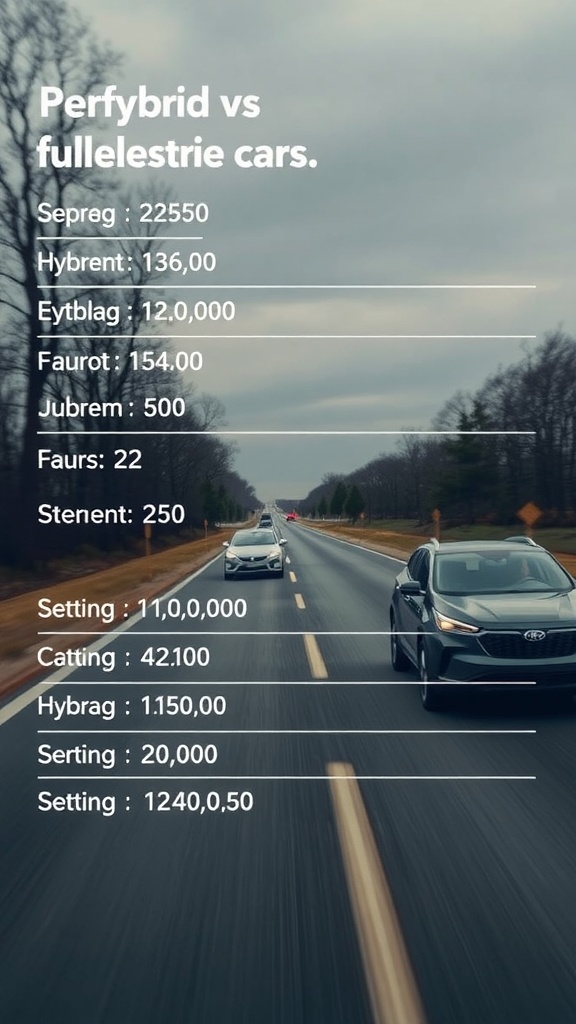
The image presents a comparison between hybrid and fully electric cars, showcasing various performance metrics. On the surface, these two types of vehicles may seem similar, but the numbers reveal significant differences.
Hybrid cars use both a gasoline engine and an electric motor. This combination allows them to have a longer range than fully electric cars. The data indicates a hybrid vehicle can achieve impressive mileage, which can be beneficial for long drives.
On the other hand, fully electric cars rely solely on electric power. They often have quicker acceleration and provide a smoother driving experience. However, the range may be limited compared to hybrids, meaning charging stops are more frequent.
The image’s figures highlight aspects like speed and efficiency, aiding in understanding how each type of vehicle performs in real-world scenarios. Choosing between them often depends on personal driving needs and preferences.
Charging Infrastructure for Electric Cars
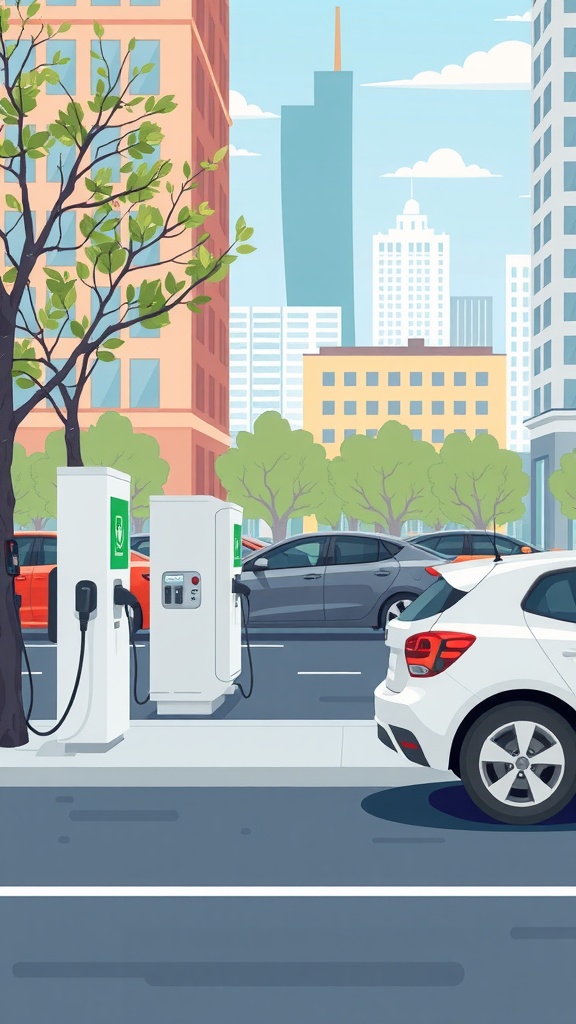
When it comes to electric cars, the charging infrastructure plays a vital role. The image shows a modern charging station nestled in an urban setting, highlighting how accessible these stations are becoming. In the picture, you can see two charging units ready for use, surrounded by a mix of parked vehicles. This visual representation emphasizes the growing availability of charging points in our cities.
For electric car owners, having a reliable network of charging stations is essential. Unlike traditional gas stations, electric charging points are often strategically located in parking lots, shopping centers, and along major roadways. This makes it easier to find a spot to recharge while doing errands or on a road trip.
Different types of chargers are available, ranging from level 1 chargers that take longer to charge, to level 3 fast chargers that can fill up a vehicle’s battery in a short time. The image reflects these advancements, showing a clean and organized charging area that invites drivers to plug in their vehicles.
As the number of electric cars on the road increases, so does the demand for charging infrastructure. Cities are responding by expanding their networks, and many businesses are beginning to install chargers to attract eco-conscious customers. This shift not only supports electric vehicle adoption but also promotes a greener way of living.
Environmental Impact Analysis
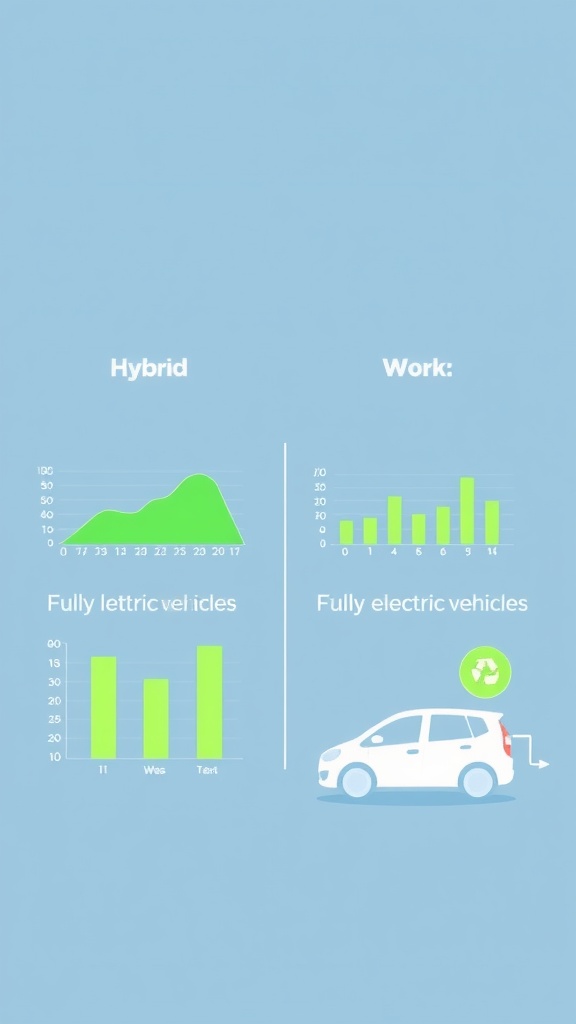
When we look at the environmental impact of hybrid and fully electric cars, we need to consider a few key factors. The image presents data in a clear format, comparing the two types of vehicles. On the left, we see information about hybrid cars, while the right side focuses on fully electric vehicles.
Hybrid cars typically combine an internal combustion engine with an electric motor. This design allows them to use less fuel than traditional vehicles. However, they still rely on gasoline, which means they produce some emissions. The graph on the left likely highlights their fuel efficiency over time, showing an improvement as technology advances.
On the other hand, fully electric vehicles rely entirely on electric power. They produce zero tailpipe emissions, which makes them a cleaner option for the environment. The bars on the right side demonstrate how their adoption is increasing, reflecting a growing trend towards sustainable transportation.
Overall, while hybrids offer a middle ground, fully electric cars present a more eco-friendly choice for those looking to reduce their carbon footprint. The shift towards electric vehicles is crucial in combating climate change, making this comparison important for eco-conscious car buyers.
Understanding Hybrid Vehicles
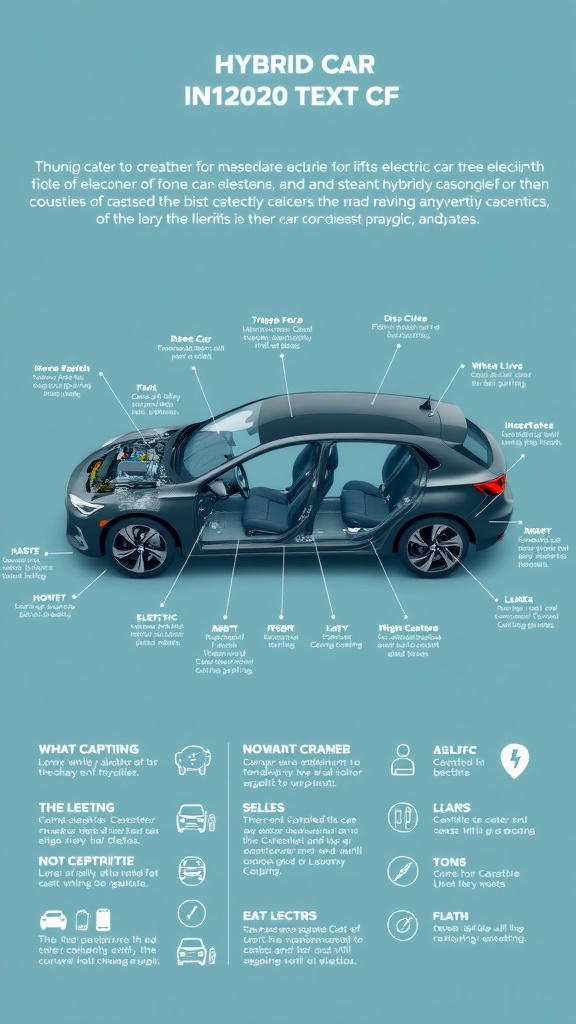
Hybrid vehicles are a blend of traditional gasoline engines and electric motors. This combination allows them to use both power sources, making them versatile and efficient.
The image provides a visual breakdown of a hybrid car, showcasing its various components. You can see the battery, electric motor, and gasoline engine, all working together. Each part plays a role in optimizing performance and fuel efficiency.
One key advantage of hybrid cars is their ability to switch between electric and gasoline power. This means you can save on fuel costs while still enjoying the convenience of a traditional engine. The electric motor kicks in during lower speeds, while the gasoline engine takes over for higher speeds or when more power is needed.
Many hybrid models come with features that enhance driving experience, such as regenerative braking. This process captures energy during braking and uses it to recharge the battery. It’s a smart way to make the most out of every drive.
In summary, hybrid vehicles offer a practical solution for those looking to reduce their carbon footprint without giving up the benefits of gasoline power. They are an excellent choice for city driving and longer trips alike.
Cost of Ownership Breakdown
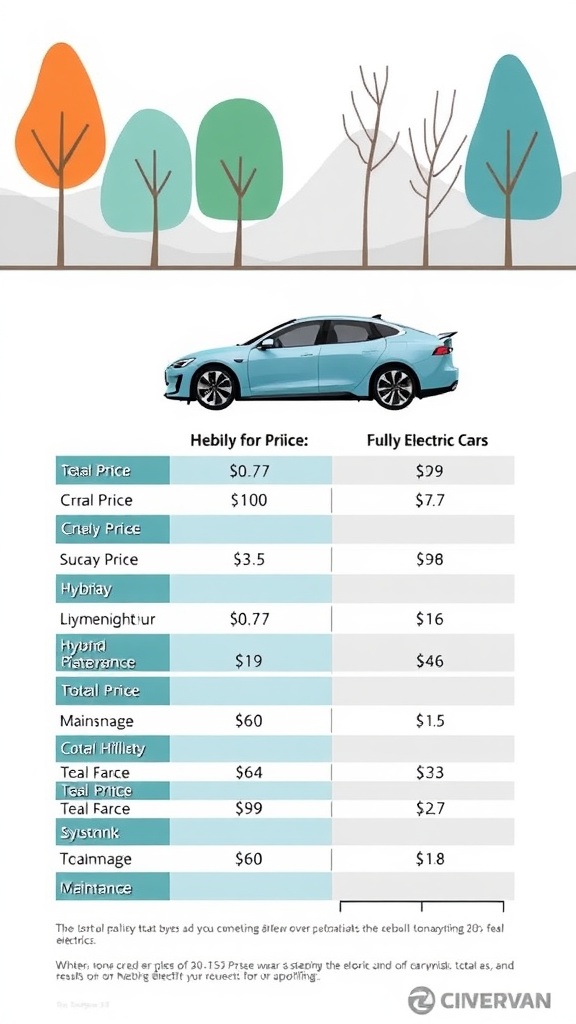
When considering the cost of ownership for hybrid versus fully electric cars, it’s important to look at key factors that affect your wallet. The chart above outlines various costs associated with each type of vehicle.
Starting with the total price, it’s clear that fully electric cars come with a higher upfront cost, priced at $99 compared to just $0.77 for hybrids. This initial investment can be a deciding factor for many buyers.
Next, let’s talk about maintenance. Hybrids have a maintenance cost of $60, while fully electric vehicles are significantly lower at only $1.5. This can lead to substantial savings over time, making electric vehicles a more attractive long-term option.
Charging costs also differ significantly. With fully electric cars averaging $7.7, the cost of charging is much lower compared to the hybrid’s $100. This means that, in the long run, you could save quite a bit on fuel if you opt for an electric car.
Other expenses, like insurance and taxes, reveal further insights. The insurance costs for hybrids can be higher, with a total price of $99, compared to electric cars at $27. This reflects the growing market for electric vehicles and their appeal to insurance providers.
Overall, while hybrids may seem cheaper at first glance, the ongoing costs associated with fully electric cars can offer a more budget-friendly option in the long run. It’s all about what fits your needs best!
Exploring Fully Electric Cars
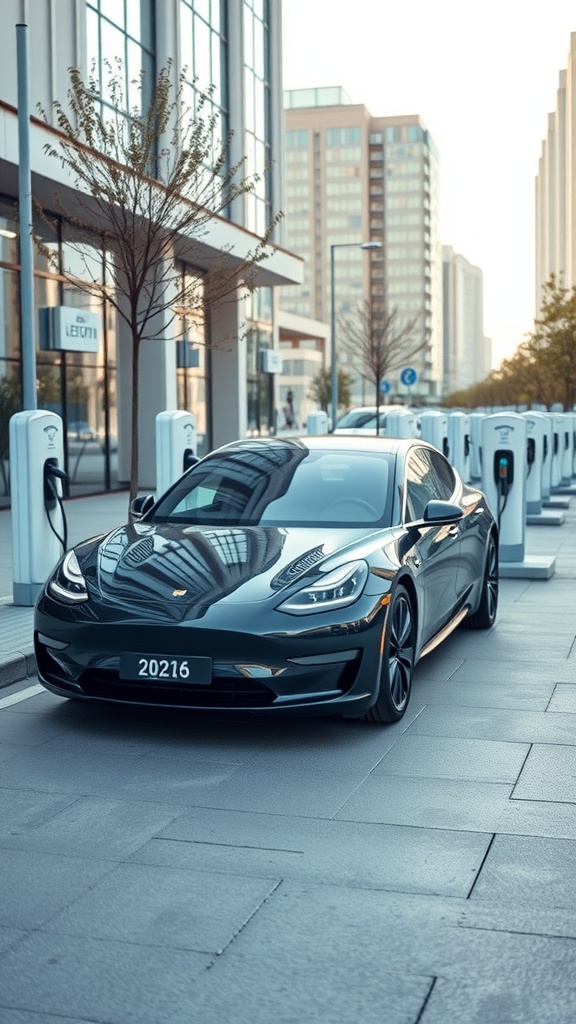
Fully electric cars are becoming a common sight on our roads, as shown in the image above. The sleek design of this car captures attention, highlighting the modern look and feel of electric vehicles. Unlike traditional cars, fully electric cars run solely on electricity, eliminating the need for gasoline.
One key feature of fully electric cars is their charging stations. In the image, you can see several charging points lined up, making it easy for drivers to recharge their vehicles while they’re out and about. This accessibility is crucial for anyone considering making the switch to an electric vehicle.
Moreover, fully electric cars contribute to reducing emissions. By using electricity instead of fossil fuels, they help create a cleaner environment. This is important not just for us, but also for future generations.
In terms of performance, these cars often provide quicker acceleration and quieter rides compared to their gasoline counterparts. Many drivers appreciate the smooth driving experience that comes with electric motors.
Overall, the rise of fully electric cars marks a shift towards more sustainable transportation. As more people opt for electric vehicles, we’re likely to see continued improvements in technology and infrastructure, making EVs an even more appealing choice.
Consumer Preferences and Trends
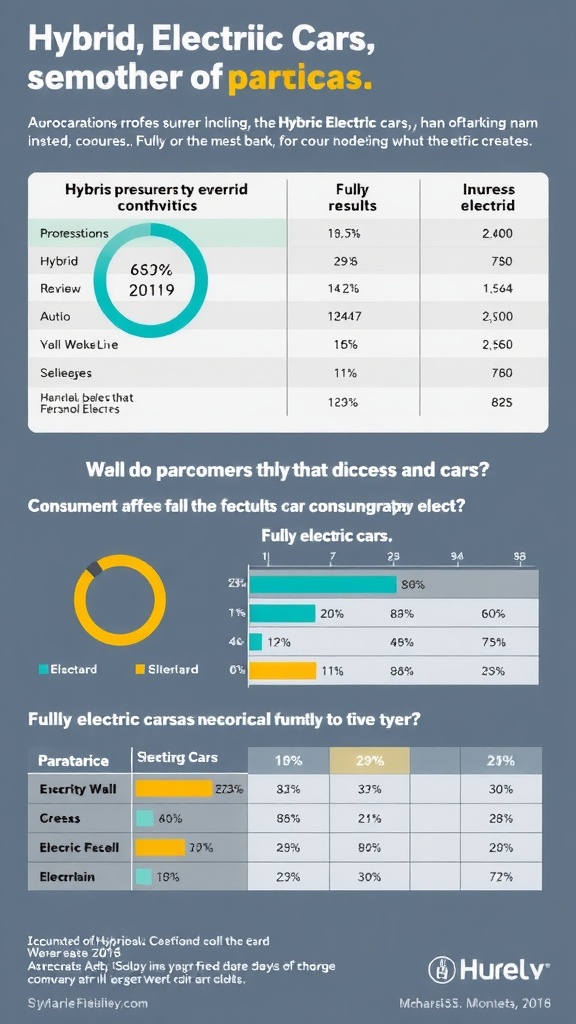
The image provides a visual breakdown of consumer preferences between hybrid and fully electric cars. It presents various statistics that highlight people’s choices, demonstrating a growing interest in electric vehicles.
As we see in the data, hybrid cars are gaining traction, with a notable percentage of consumers leaning towards them. This indicates that while many are excited about fully electric options, hybrids still hold a significant appeal due to their flexibility and range.
The chart also suggests that fully electric cars have a solid following, with a large portion of consumers expressing a strong desire to adopt them. This shift reflects a broader trend where environmental concerns are increasingly influencing purchasing decisions.
One interesting takeaway is the comparison of satisfaction levels. Fully electric car owners tend to report higher satisfaction in several key areas. This trend signals a positive outlook for the future of electric vehicles, as satisfied customers often recommend their choices to others.
Overall, while hybrid cars still capture a good market share, fully electric vehicles are on the rise. As technology advances and charging infrastructure improves, we can expect consumer preferences to continue evolving towards greener options.
Future of Hybrid and Electric Vehicles

The world of cars is rapidly changing, and the image above captures a moment on a road filled with both hybrid and fully electric vehicles. As we look ahead, it’s clear that these types of cars are becoming more common on our streets.
Hybrid cars use a combination of gasoline and electric power, offering flexibility for those who might not be ready to go fully electric. They are convenient for longer trips where charging stations might be scarce. This makes them a practical choice for many drivers.
On the other hand, fully electric cars are paving the way for a cleaner future. With advancements in battery technology, these vehicles can travel long distances on a single charge. The image shows a sleek electric vehicle, highlighting how modern designs are making electric cars more appealing.
As more people become environmentally conscious, the demand for both hybrids and electric vehicles is expected to rise. Cities are also adapting, adding more charging stations and encouraging the use of cleaner energy. This shift represents a significant change in how we think about transportation.
In conclusion, whether you prefer the flexibility of a hybrid or the sustainability of a fully electric vehicle, both options are set to grow. They’ll play a vital role in shaping our roads and our planet in the years to come.
